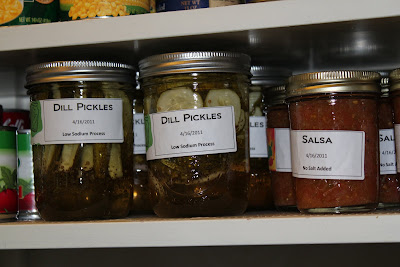Commercial pickles are loaded with sodium, which is really a shame, since otherwise, they are extremely low in calories, and naturally fat free. Many pickles are made by fermentation, a time-consuming endeavor that requires a large amount of salt in the process. Other pickles recipes use a fresh-pack process, where salt is added only as a flavoring, and is not part of the preservation process. The USDA Guide to Home Canning includes a recipe for reduced sodium dill pickles, and that was today's goal!! While many people are mystified by the "magic" of home canning, and are intimidated by stories of exploding peaches seething with botulism, the principles behind home canning are as simple as a science experiment we all did in 5th grade! Heat makes the food expand, forcing air out. When heat is removed, the contents return to their original volume, creating a vacuum that creates an airtight seal. It's that easy- IF you follow the instructions!
So, with cucumbers washed, and sorted by size for even packing, we're ready to start the process!
All of the miracles take place in a boiling water bath, so getting a BIG pot of water to a boil is the first step. If you make a huge haul at the farmer's market (or are lucky enough to have a really big garden!) you could keep a canner kettle running all day long! Pickles are considered a high-acid food, so a water bath canner- or a really big stockpot- is all you need for fresh-pack pickles!
The process is pretty logical, once you understand the concept. Once the water is boiling, place the empty jars, lids, and rings into the water bath to sanitize while you prepare the rest of the ingredients. According to the USDA, if your recipe processes in a hot water bath for 10 minutes or more, which this one does, the sanitation step is not necessary, but it was in the recipe, so we did it! The lids, which should be new every time, must be boiled to activate the sealant. Rings and jars may be reused, but the lids have to be replaced, since the sealant is designed for a single use.
 While the jars and lids boil, we prepare the "pickle juice" in a stainless pot. Basically a mixture of vinegar, sugar, and spices, this liquid will provide the acidity needed to prevent spoilage. While the "juice" simmers, slice the cucumbers. Once the juice is boiling and the jars are sanitary, remove the jars from the water bath, fill with slices and spices according to the recipe, and apply the lids and rings.
While the jars and lids boil, we prepare the "pickle juice" in a stainless pot. Basically a mixture of vinegar, sugar, and spices, this liquid will provide the acidity needed to prevent spoilage. While the "juice" simmers, slice the cucumbers. Once the juice is boiling and the jars are sanitary, remove the jars from the water bath, fill with slices and spices according to the recipe, and apply the lids and rings. One place where TLSQ varied from the recipe was the inclusion of Pickle Crisp Granules, made by Ball. Remembering the rather limp and disappointing pickles once made by the Queen Mum, we decided to give this product a try. We also left it out of one jar for comparison. Unfortunately, the "control" jar was not labeled, so if the difference is not dramatic we may never know the value of this product!
When the jars are filled and closed, they go into the water bath for their 15 minutes of magic. During these 15 minutes, the temperature within the jars will rise enough to kill any living bacteria and expand the contents to expel trapped air. After 15 minutes of processing, the jars are removed and allowed to cool naturally. As the contents cool, the product returns to it's normal volume, sealing the lid against the rim of the jar and creating a vacuum, causing the domed lids to reverse from concave to convex with a satisfying "ping", verifying that the vacuum is intact and the contents are, in fact, sealed.
Pickles require a bit of shelf time to develop their flavor, so we can't offer a taste verdict just yet. Check back in a week or two and find out the results of "the Great Low Salt Pickle Experiment"!








No comments:
Post a Comment